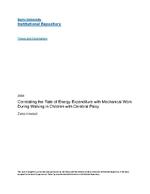|
|

Notes
- Abstract:
- There are numerous methods used to quantify energy expenditure during gait by means of measuring mechanical work, but when applied to various populations their results differ up to 1000% . Children with cerebral palsy (CP) relative to their peers, expend as much as three times more energy during walking, and show even greater relative expenditure during higher intensity activities. As a result, the actual efficiency of gait is hard to establish, and indirect calorimetry is the only reliable measure of metabolic cost. However, this method is not practical for use in children with CP, and health professionals most often rely on verbal feedback from the patients, and gait analysis, to compare the gait parameters to normal gait. Therefore, the purpose of this study was to correlate calculations of mechanical work used in previous studies, with indirect calorimetry, in order to establish a reliable measure of gait efficiency. It is hypothesized that measures of total body energy using segmental energies in addition to movement of center of mass will yield significant correlation with metabolic measures. Also, mechanical work using energy transfer, and assuming no energy transfer will also yield significant correlation with indirect calorimetry. It is also hypothesized, that results for work with transfer of mechanical energy should yield lower mechanical energy than that of work without energy transfer. Nine (9) males and one (1) female patient, ages 7-17 years, diagnosed with spastic cerebral palsy were examined. Metabolic data was measured using Cosmed, K4b2 telemetry system. Video data were collected and processed using an eight camera EvaRT video system. The results indicated significant correlation of calorimetry with total energy using segmental energies relative to the center of mass (COM). The mechanical work solely measuring COM with and without energy transfer also was found to have significant correlation with indirect calorimetry. In addition, the results support the claim that work assuming energy transfer will be significantly lower than work assuming no energy transfer between body segments. The results of this study confirmed the initial hypotheses. All three models for mechanical work showed significant correlation with indirect calorimetry, whereas the model in which segmental transfer of energy is taken into consideration yielded a stronger correlation than the work analyzing solely the potential and kinetic energies of the whole body. In addition, the results also support the claim that work with assumed energy transfer was significantly lower, than work where no energy transfer is taken in consideration. It is also found that a significant portion of the total metabolic cost in gait is attributed to work required to move COM. The major limitation in this study was the sample size; however, the strong significant results are sufficient to further expand on the models used in this study.
- Thesis:
- Thesis (M.S.)--Barry University, 2008.
- Bibliography:
- Includes bibliographical references (leaves 52-54).
Record Information
- Source Institution:
- Barry University
- Holding Location:
- Barry University Archives and Special Collections
- Rights Management:
- Copyright Zarko Krkeljas. Permission granted to Barry University to digitize, archive and distribute this item for non-profit research and educational purposes. Any reuse of this item in excess of fair use or other copyright exemptions requires permission of the copyright holder.
- Resource Identifier:
- RJ496.C4 K75 2008_KrkeljasZarko ( BU-Local )
- Classification:
- RJ496.C4 K75 2008 ( lcc )
|
|